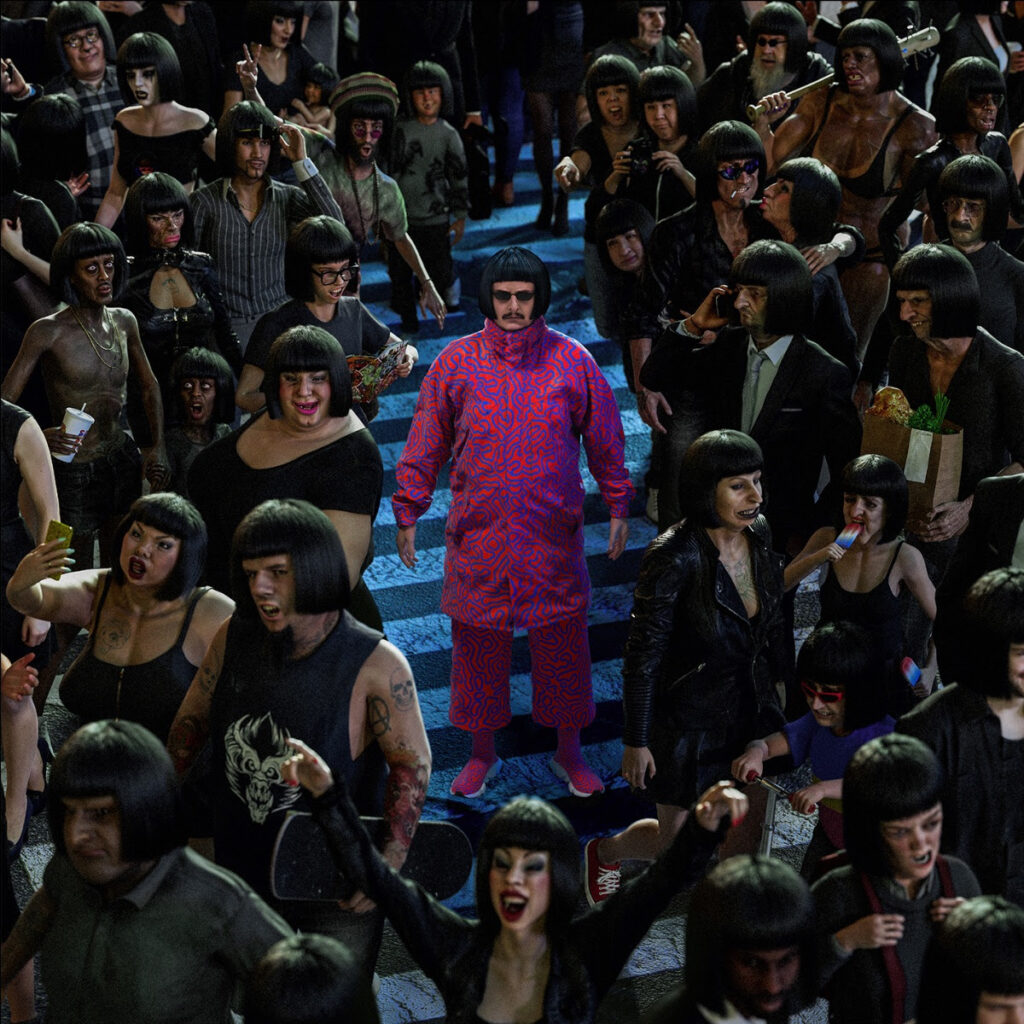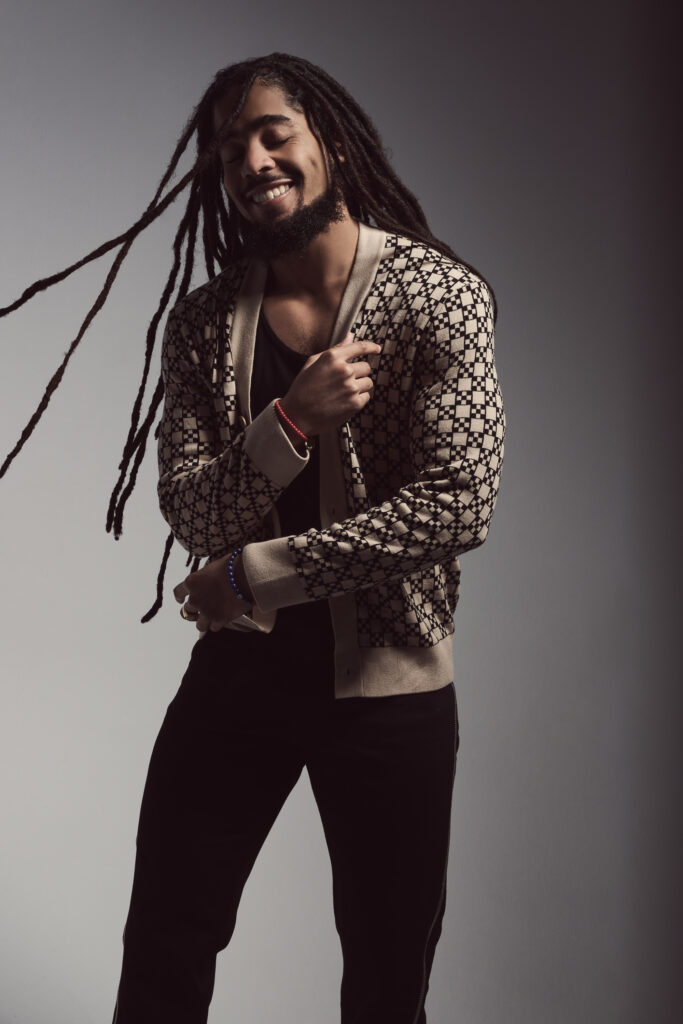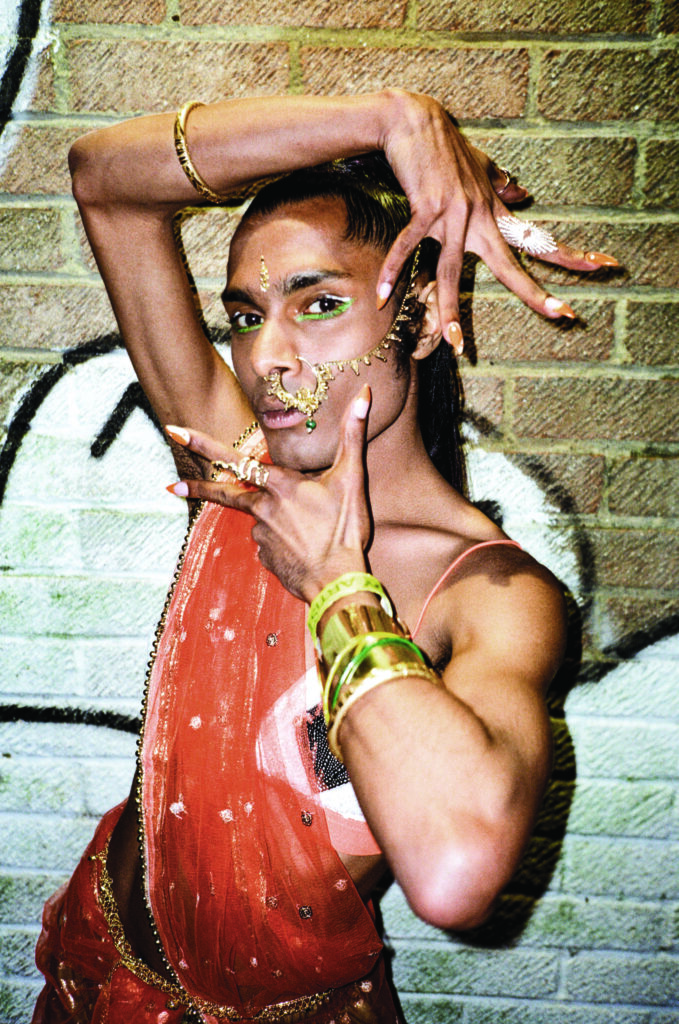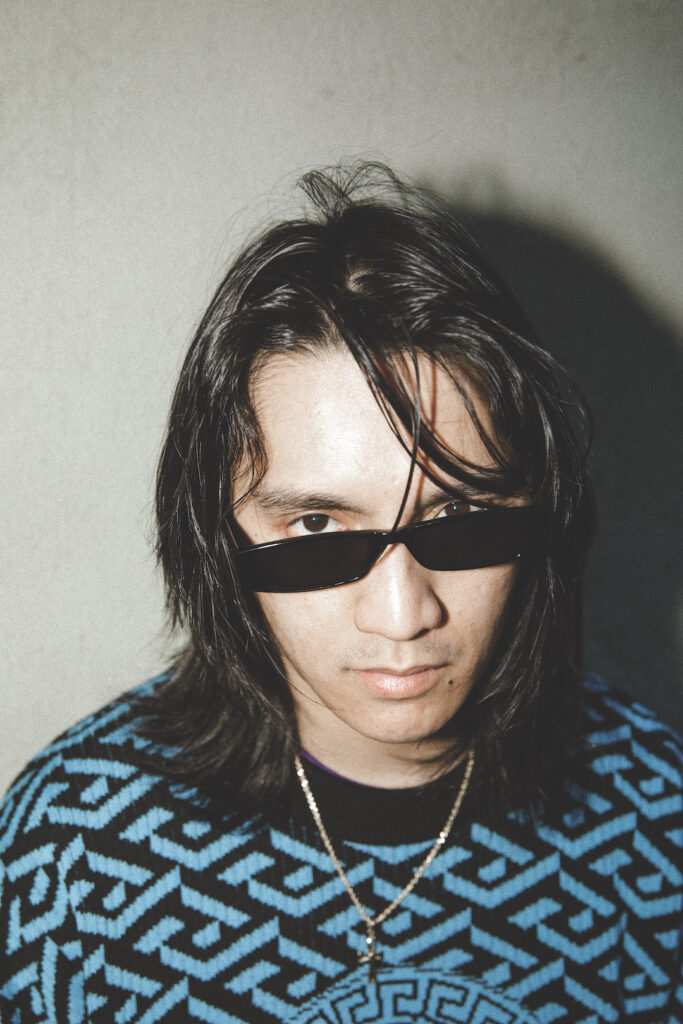Mumbai-Based Artist Santanu Hazarika Gives a Glimpse of His World
PHOTOS COURTESY of SANTANU HAZARIKA
 Multidisciplinary art rebel, metal head, and world doodle champ Santanu Hazarika is clocking meteoric fame and inspiring India’s new-gen as one of the most wildly diverse in the game. The sun is going down in Mumbai as he slides into frame. It’s the middle of one of the hottest summers on record. And he’s back in his studio, fresh off the plane from a weekend on the beach in Goa celebrating his manager’s birthday amid a meteoric career trajectory that shows no signs of slowing down.
Multidisciplinary art rebel, metal head, and world doodle champ Santanu Hazarika is clocking meteoric fame and inspiring India’s new-gen as one of the most wildly diverse in the game. The sun is going down in Mumbai as he slides into frame. It’s the middle of one of the hottest summers on record. And he’s back in his studio, fresh off the plane from a weekend on the beach in Goa celebrating his manager’s birthday amid a meteoric career trajectory that shows no signs of slowing down.
He’s sporting a crisp black t-shirt and an infectious smile that radiates through pixels. Santanu has every reason to be happy. He’s off the back of creating India’s fastest selling NFT; it sold in a record 37 seconds and he’s back from a recent partnership with Porsche and is making his directorial debut with megastar partner, Shruti Haasan among a lengthy list of other illustrious creative collaborations.
In a little over half a decade, he’s raked in the accolades and cemented his status enough to be inspiring legions of talented young creatives across India. His story is leading them to embrace their own uniqueness and follow their dreams. He grew up in the city of Guwahati in the northeast Indian state of Assam. “We’re only connected to the mainland by a small blob of land,” he says, explaining how his feeling of being an outsider goes back to childhood.
Assamese people look different. We have a different culture. Most people think we’re Chinese. I was always discriminated against. In fact, I was a misfit in every other category. I wasn’t that good at studies. I was not good at sports, and I was never into what the popular kids were into. All my friends were in hardcore heavy metal bands but I could never play an instrument, I couldn’t sing. I never fit into any of the molds, but I stood out as a visual artist.
His outlet was simple pen and paper. He had a talent for art from an early age. ”I always liked comic books and drawing. One of my first comic books was Spawn. “I was immediately drawn to the violent imagery. When I was five or six years old, I would go into all these comic bookstores, where they’d keep all the hand-me-downs basically, and I would go in and buy all the leftover comics on sale. I had no idea what the issue number or story was, but I’d buy the ones with the most violent or goriest covers and just liked looking at the images. It was very sexual. It was very violent. It was R-rated, basically. But whenever I would tell my parents that I was going to the comic bookstore, they wouldn’t care. They’d think, ‘oh, this guy is going there to buy some cartoons, PG-13 stuff.’”
Santanu’s folks were as oblivious to their son’s early penchant for subversive content as they were to his lucrative business hustle. He copied the most graphic covers and sold them for a fast buck around school to get his hands on more comics and fit in. Soon, he swapped sketching comics for drawing characters, like Eddie from Iron Maiden in various forms and his favorite album covers from Megadeth and word got out about his pen game. By the time he hit his teens, he was in high demand. “I was getting better at it. All my friends had bands. I always wanted to be in the band but I didn’t have the talent for it, so I thought maybe I’ll just make the album cover. I figured I’ll be in the shows like ‘I’m with the band!’” I did it for a few beers, admission to shows and purely out of love for the music. I loved the whole scene that was happening and now I felt like I contributed to it.” he beams.

Growing up, there were a lot of issues with militants and terrorism in his hometown. There was poverty, drugs, and violence—the perfect combination for a punk mindset. “I would say that was my most rebellious time as a teenager and the one that’s stuck with me the most. It was the start of me discovering what the color black represented, and my love for it. As metal kids, we dressed in black all the time. We had a lot of independent shows happening in small, rundown venues. All packed with kids just wildin’ out. There was a lot of alcohol, a lot of substances. I was either getting into fights or beaten up in mosh pits, breaking barricades, crazy stuff.”
Pen and paper were calling, but Santanu didn’t know how to answer.
I had no idea how big this art thing would get. I never believed that I could make something out of it because where I grew up and in the kind of society that I was living in…they had no exposure to it. They had no idea that you could make a living by being an artist, designer or visual artist. All this was a hobby and I was conditioned to believe that. In India, if I said to my parents: ‘I want to be an artist’, they would just whack me and say, ‘what’s the point of that? Do something more meaningful!’ and those are the kind of stereotypes I battled. I had to fight almost all my life. I had to prove that wrong.”
That time would come; but first Santanu followed his father’s footsteps and went to college to pursue mechanical engineering. “I was always into science. I thought I’d do good. But when I joined college, I started getting more exposed to art and what happens outside the little bubble I’d existed in. I slowly became aware of all the opportunities I could pursue with this talent.” But just as his mind opened, his creative spirit began shutting down.

“I was miserable with my engineering degree because I really sucked at it. I had no interest in it. It was really bad. I was clinically depressed for three to four years and on medication. That completely stopped me from drawing and making art. It completely neutralized every emotion I ever had. I felt like a bloody robot. I didn’t like that feeling.”
He confesses that he tried several times to get off meds, but his whole world would come crashing down. “I didn’t like the fact that I depended on something so much that was so synthetic and inorganic. The situation was really hard. Finally, I had to say to myself, ‘ok, I can’t continue doing this, pursuing engineering. I want to get into art and design, and I don’t know if I’ll be successful at it, but I know I can give my best if I start doing what I really like doing.’”
Despite his abysmal grades, Santanu couldn’t get expelled from college if he kept attending, and he certainly couldn’t sit around drawing at home. So the only answer was relentlessly drawing in class. “I couldn’t simply bounce. But I completely stopped the meds and started drawing again. I lied and said that I was still taking them but I would just throw them away. Every day, I went to college, sat down on the last bench and kept sketching. I think the best years of my engineering study were then. I really had a point to prove.”
He started reading up on metaphysics, philosophies and mythologies. Likewise, his art gravitated from anime and comic characters to his own creations. “I had learnt all the skills of drawing, which can be considered the alphabet of this visual language. Now, I started forming my own sentences. I started researching and getting more ideas. I started composing my own stories from the skillset I had learnt through mimicking others.”
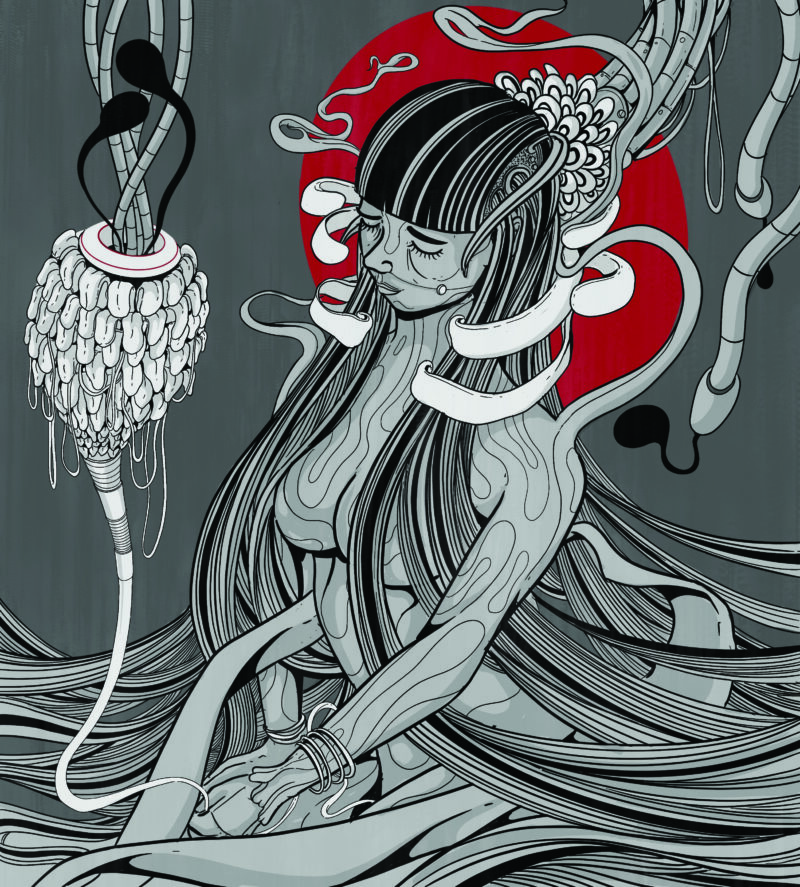
That went on for four years. “I was failing for sure. I thought I’d keep attending my classes, but I wouldn’t attend my classes. I was fighting back. I deliberately failed my exams so many times. There’s a rule that you have to stay in the examination hall for at least one hour before you can turn in your paper. So I would go in, be blazed, and just draw on my answer sheets—drawing, drawing, drawing. The professors would allow me to do it, if they could take all my answer sheets home. They liked my drawings so much, they let me get away with it. Otherwise, they could be really strict. If I were to have completed my degree, I think it would have taken me eight years, if you include all the retests I would’ve needed,” he jokes.
Around the same time, a friend tagged him in a post for the Red Bull Doodle Art Competition and Santanu’s life would never be the same. He entered the national championships with an illustration inspired by a book he was reading called 7 Secrets of Vishnu by Devdutt Pattanaik. He summarized Vishnu’s philosophies in the drawing, took home the title as the winner, and secured a ticket to Cape Town, South Africa for the world finals. “I thought, ‘ok, maybe this is an opportunity for me to actually get out of this shit storm that I’m in right now’ and I actually never stepped foot onto campus again. They weren’t going to allow me to go to the competition because I wouldn’t have been able to take my final exams but I was like, ‘screw that.’”
Around 40 countries would be competing in the Cape Town South Africa finals but Santanu was enjoying his national win well enough as it was. “Honestly, I didn’t care if I won. I just wanted a nice vacation! I had never been out of the country ever in my life.” With his bags packed, he finally told his parents his plans. “They didn’t believe me at first, like, ‘how can this scribbling around get you a national title?!’ I was like, ‘It’s happening. I’m going, sorry.’”

Santanu returned as the global winner with an incalculable confidence that ignited his path to becoming a star of the art world. “I had to go and win a bloody world championship just to validate the simple point that I wanted to be an artist. But after I did, when I returned to India, I basically said ‘fuck you’ to everyone who said I couldn’t do it.”
Few would put up a fight. Santanu signed his first art contract with Red Bull and, not long after, he was inundated with projects across a staggering spectrum of mediums. “I said ‘yes’ to everything, even though I didn’t technically know how to execute the project or even write a formal email. I only knew drawing, and with pen/ink, on paper. Everything else that followed, I learned on the job. I would have deadlines where they wanted a whole product design, a giant canvas piece, I would work hard and learn how in a few days, and just execute it.”
Fast forward to 2022, and he’s produced an immense portfolio of personal projects and flash collabs. He appeared on the cover of GQ magazine and had his first art exhibition featured in Rolling Stone India. He’s designed custom Stan Smith’s for Adidas accompanied by three-story murals in their flagship store, and created an exclusive collaboration with cult label Dust Of Gods.
“I got into branding,” he says. “I got into making murals. I got into live shows. I recently collaborated on customizing motorcycle helmets. There’s been so many. I started my directorial debut with Amazon on a Hindi series called Bestseller that has my partner, Shruti Haasan in the lead role. I co-directed a music video. I made artwork for a Major Lazer & Nucleya single. I did an NFT collab with a rapper called Divine. Raftaar…Ritviz…MC Altaf…I’m doing album artwork for some of the biggest metal bands, hip-hop and pop stars in India right now. I was even commissioned to do artwork for the US bands Polyphia and Veil of Maya.”
He barely takes a breath when describing what excites him. “I did a two-hour improvised set with a live jazz band where I painted the back of the stage. I did a whole abstract piece with the music. I shared the stage with one of the biggest Bollywood stars for a television telethon where I painted a tree live for twelve hours. I’m customizing gaming equipment. I designed the bus art for the [Rajasthan Royals] cricket team. A lot is going on.”

On the topic of live performances, one of Santanu’s most prestigious collaborations found him painting a Porsche Panamera over three days in a performance art piece where he was the main attraction. “At one point, there was a whole fashion show around the car I was painting!”
With a list like that, his greatest inspiration comes as no surprise. “I still really wanna make album artwork for Megadeth because that’s one of our (he and his partners’) favorite metal bands. I would also like to do one for Meshuggah, one of my other favorites. Among my biggest inspirations is Kanye. I want to make clothes with him. I love him. He’s just amazing to me. I can see a bit of me in him. I can relate to him, his vision, and how he stuck by it. Maybe one day, I’ll have the honor to meet or work with him. That’s one of my biggest dreams, actually.”
Santanu has made himself an enigmatic force, impossible for the press to define. They’ve recently taunted the tireless artist by calling him a rapper among the many of their out-of-this-world titles. Always playful and rebellious, he quickly claps back, “just for the heck of it, I’m making a track. I’m already on it! Might just fuck with some of them press people.”
When he isn’t making headlines, he’s drawing. He lights up when talking about all the works of art he’s creating. He’s incredibly hyped about a handful of global projects dropping next year. He’s begun painting with ink and acrylic inspired by Takashi Murakami. He’s gearing up to judge the Red Bull Doodle Art world finals and finally confirms that eventually when the timing is right, he might even cave to the constant fan pressure to create a comic book.
As we close, it’s impossible not to ask him what he considers to be his most significant accomplishment thus far.
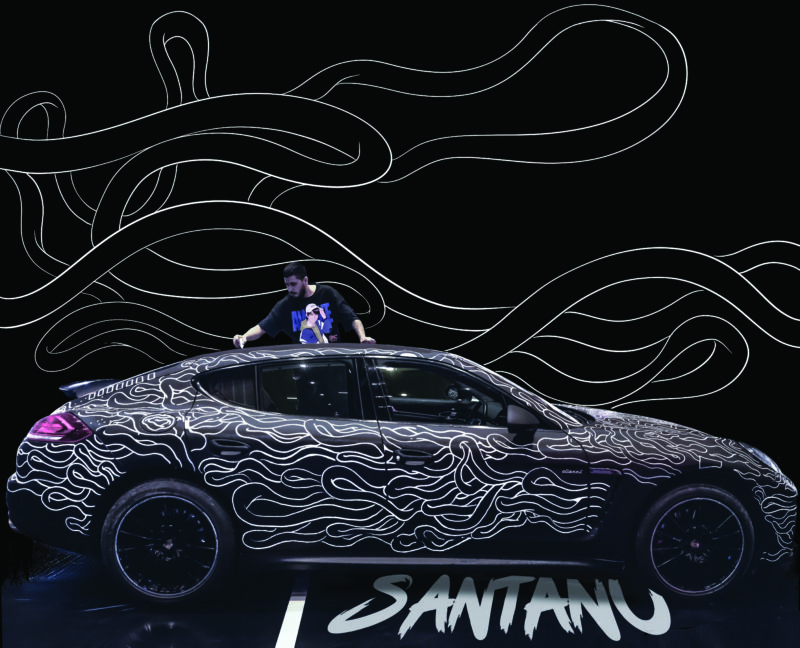
I get messages every morning from all these kids coming from small towns and cities where nobody gets them. Nobody understands art or their talents. Those messages really touched me because that was me! I feel like those messages are my biggest achievement. Not winning competitions or working with famous people or brands. For me, it’s just to inspire that kid in that town. Because when I was asked who I looked up to, I didn’t have an example from my community to show them. I have a lot to be proud of, but these messages are where I feel really inspired, humble and grateful. All of our stories and journeys and experiences are different. But the most important thing I can achieve, is if one kid can let their uniqueness be his artwork and use my journey as an example to their parents, their friends, society and say, ‘see, he made it, so can I!
@santanu_hazarika_art




